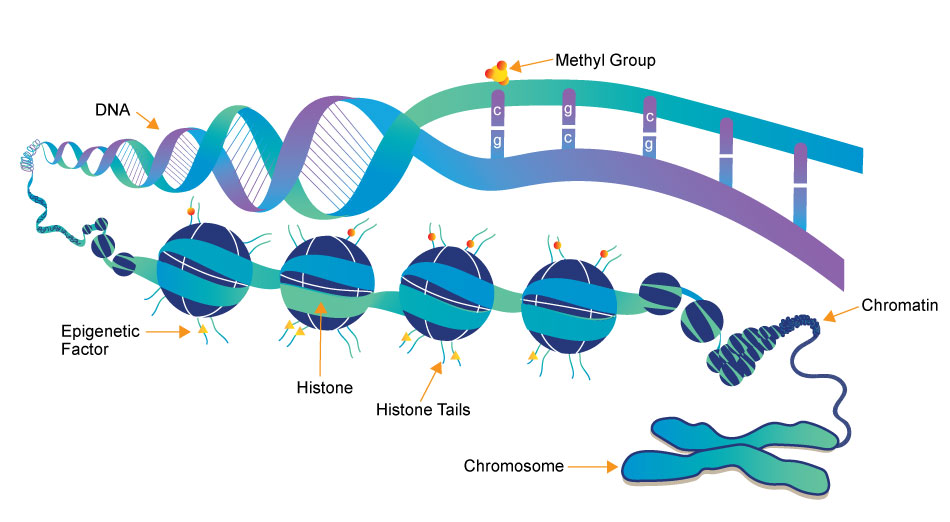Epigenetics


Epigenetics research delves into the molecular mechanisms that control gene expression and cellular traits without altering the underlying DNA sequence. One crucial aspect of this field is the role of small molecules, which act as powerful regulators of epigenetic modifications. These small compounds, typically comprising a few dozen to a few hundred atoms, have emerged as essential tools in understanding and manipulating the epigenome.
- DNA Methylation Inhibitors: Small molecules like 5-azacytidine and 5-aza-2'-deoxycytidine are DNA methyltransferase inhibitors. They block the addition of methyl groups to DNA, leading to DNA demethylation. This can reactivate silenced genes, potentially offering therapeutic avenues for conditions like cancer.
- HDAC inhibitors: HDACs remove acetyl groups from histone proteins, contributing to gene repression. Small molecule HDAC inhibitors, such as Vorinostat and Romidepsin, can reverse this process by increasing histone acetylation, allowing genes to be more accessible for transcription. These inhibitors are being explored for cancer therapy and other conditions.
- Histone Methyltransferase Inhibitors: Small molecules like GSK126 inhibit specific histone methyltransferases, affecting histone methylation patterns. This can alter gene expression, making them promising candidates for cancer and other diseases with epigenetic dysregulation.
- RNA Modulators: Small molecules can also target non-coding RNAs involved in epigenetic regulation. For instance, small molecules called small interfering RNAs (siRNAs) can be designed to target and degrade specific long non-coding RNAs, influencing gene expression.
- Epigenetic Reader Domain Inhibitors: These small molecules target proteins that recognize and bind to specific epigenetic marks. Examples include inhibitors of bromodomain-containing proteins (BET inhibitors), which can disrupt gene regulation by interfering with protein-DNA interactions.
Small molecules in epigenetics research not only provide insights into the fundamental biology of gene regulation but also hold immense promise for developing novel therapeutics. Their ability to selectively modulate specific epigenetic marks and pathways has led to ongoing clinical trials and drug development efforts for various diseases, including cancer, neurological disorders, and inflammatory conditions. Understanding and harnessing the power of these small molecules is at the forefront of modern epigenetics research, offering new hope for precision medicine and targeted therapies.
3 key components involved in the regulation of epigenetic modifications
Epigenetics Writer
Epigenetics writers are enzymes responsible for adding chemical marks or modifications to DNA or histone proteins. These marks include DNA methylation (addition of methyl groups to DNA) and histone modifications (such as acetylation, methylation, phosphorylation, etc.).
Epigenetics Reader
Function: Epigenetics readers are proteins that can recognize and bind to specific epigenetic marks on DNA or histones. These reader proteins interpret the epigenetic code and facilitate downstream cellular processes, such as gene activation or repression.
Epigenetics Eraser
Function: Epigenetics erasers are enzymes responsible for removing or reversing epigenetic marks on DNA or histones. This process allows for the dynamic regulation of gene expression and the resetting of epigenetic states during various stages of development and in response to environmental changes.
-
Histone Demethylase 抑制剂
JIB-04 是一种广谱选择性的 Jumonji 组蛋白去甲基化酶抑制剂,其半抑制浓度(IC50)分别为 JARID1A 230 nM、JMJD2E 340 nM、JMJD3 855 nM、JMJD2A 445 nM、JMJD2B 435 nM、JMJD2C 1100 nM 和 JMJD2D 290 nM。- Thibaud Reyser, .et al. , Pharmaceutics, 2023, Oct 10;15(10):2440 PMID: 37896200
-
EZH2 抑制剂
3-脱氮奈普罗新 A(也称为 DZNep)是一种著名的组蛋白甲基转移酶抑制剂,它能够破坏多梳抑制复合体 2(PRC2),并在癌细胞中诱导凋亡,同时抑制增殖和转移,包括急性髓性白血病、乳腺癌和胶质母细胞瘤。 -
BET bromodomain 抑制剂
RVX-208 是一种强效的 BET 溴结构域抑制剂,其对 BD2 的 IC50 为 0.510 uM,对 BD1 的选择性约为 170 倍。 -
HDAC6 抑制剂
Nexturastat A 是一种芳基脲衍生物,作为组蛋白去乙酰化酶6(HDAC6)的强效和高度选择性抑制剂(IC50= 5.02 +/- 0.60 nM)。 -
BET 抑制剂
GSK1324726A(I-BET726)是一种新型、高效、选择性的小分子 BET蛋白 抑制剂,对 BRD2(IC50= 41 nM)、BRD3(IC50= 31 nM)和 BRD4(IC50= 22 nM)具有高亲和力。- Zhengjun Liu, .et al. , Cell Death Dis, 2020, May 5;11(5):318 PMID: 32371868
- GSK 525768A 是 GSK 525762A 的对映体化合物,后者是一种强效的小分子抑制剂,能够干扰 BET 家族的溴结构域(Brd2、Brd3 和 Brd4)的功能;GSK 525768A 对 BET 没有活性。
-
Dual Syk and JAK 抑制剂
PRT062070 是一种新型口服双重脾脏酪氨酸激酶(Syk)和 janus kinase (JAK) 抑制剂。Cerdulatinib 优先抑制 JAK1 和 JAK3 依赖的细胞因子介导的信号传导和各种细胞类型的功能反应。 -
PARP-1 抑制剂
Rucaparib 是一种强效的纯化全长人类 PARP-1 抑制剂,并且在 LoVo 和 SW620 细胞中显示出更高的细胞 PARP 抑制作用。- Jianwei Dou, .et al. , J Sep Sci, 2020, Dec 4 PMID: 33275824
-
multi-targeted tyrosine kinase 抑制剂
Cerdulatinib(PRT-062070)是一种口服活性的多靶点酪氨酸激酶抑制剂,其IC50分别为JAK1/JAK2/JAK3/TYK2和Syk的12 nM/6 nM/8 nM/0.5 nM和32 nM。 -
NAD(+)-dependent histone deacetylase Sir2p 抑制剂
Splitomicin 是一种选择性的 NAD(+)-依赖型组蛋白去乙酰化酶 Sir2p 抑制剂,其 IC50 为 60 uM,在基于细胞的实验中显示出更高的活性。 -
KAT5 (Tip60), p300/PCAF 抑制剂
阿纳卡尔酸是一种强效的 p300 和 p300/CBP-associated factor 组蛋白乙酰转移酶抑制剂。 -
JAK 抑制剂
Filgotinib 是一种选择性的 JAK1 抑制剂,其 IC50 分别为 JAK1 的 10 nM、JAK2 的 28 nM、JAK3 的 810 nM 和 TYK2 的 116 nM。 -
HDAC 抑制剂
Santacruzamate A(CAY10683)是一种强效且选择性的HDAC抑制剂,对HDAC2的IC50为119 pM,对其他HDACs的选择性超过3600倍。 -
Sodium channel blocker/DNMT 抑制剂
Procainamide HCl 是一种钠通道阻滞剂,同时也是一种DNA甲基转移酶抑制剂。 -
KAT5 (Tip60) HAT 抑制剂
MG149 是一种强效的组蛋白乙酰转移酶抑制剂,对 Tip60 和 MOF 的 IC50 分别为 74 uM 和 47 uM。- Thibaud Reyser, .et al. , Pharmaceutics, 2023, Oct 10;15(10):2440 PMID: 37896200
-
Pan-PIM kinase 抑制剂
CX-6258 HCl 是一种高效的全面 Pim激酶抑制剂,具有口服功效,对 Pim1、Pim2 和 Pim3 的 IC50 分别为 5 nM、25 nM 和 16 nM。 -
HDAC 抑制剂
4SC-202 是一种口服生物可利用的苯甲酰胺类化合物,它是人类 I类组蛋白去乙酰化酶(HDACs)同工酶1、2和3的抑制剂,具有潜在的抗肿瘤活性。




